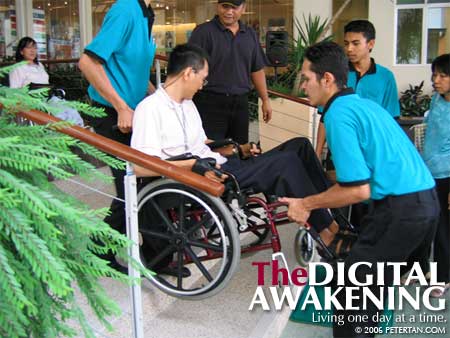Removing The Steps Of Disablement

Bless these Muslim youths who, despite the month of Ramadan, selflessly exerted great amount of energy to help my friends and me up and down a flight of steps. Without them, we would have been stranded. Their kindness is commendable. Carrying a wheelchair down a flight of steps with someone sitting on it is no easy feat. One misstep and all would have gone tumbling down.
Nevertheless, this is what wheelchair users have to risk all the time. The environment in Malaysia is very handicapping to people who are mobility impaired. That is the reason why wheelchair users like me call ourselves “disabled persons.” We are disabled by social construct. More than anything else, it is the perception of how things should be that is creating untold inconveniences for us.
On November 10, Bernama quoted Youth and Sports Minister Datuk Azalina Othman Said as saying that the ministry is “aware that presently, not all sports facilities in the country are disabled-friendly’ and that “the cost of hosting KL ’06 (9th FESPIC Games) was high because of the need to provide additional facilities for the disabled.”
This is the often heard misconception that disabled persons require special or extra needs as compared to the non-disabled. Consequently, providing these needs would incur an exorbitant expenditure. This issue is often misunderstood by many, including government officials and even disabled persons themselves. Cost should not be touted as the reason why barrier-free amenities are lacking in Malaysia. The question of additional or extra or special needs should not arise either. This is about basic needs that everyone is entitled to whether they are disabled persons or not.
Take the flight of steps as an example. If a ramp with a gentle gradient is built over it, there is no longer a need to carry me up or down anymore. If one is to argue that building a ramp constitutes a special and extra need, than what does constructing that flight of steps mean? Take away the ramp and people with mobility impairments become disabled. Take away the steps as well and the non-disabled become disabled too because they will be unable to get into the building. In this sense, how can a ramp be considered an additional facility while steps are not?
Steps and ramps are means of accessibility. Access to buildings and all public amenities should be constructed to be functional to everyone. This is very seldom the case though. It is apparent that most of the obstacles disabled persons have been encountering originated from a skewed perception of how things should be. The consequences of this perception in turn prevent disabled persons from participating fully in society.
Just because things have been done the same way for thousands of years do not mean that we must continue doing it the same way now. Nevertheless, architects continue to design buildings with steps but without ramps while local councils continue to turn a blind eye to these blatant omissions.
The Uniform Building By-Law (UBBL) 34A stipulates that disabled persons must be provided with access into public buildings. It states that the requirements “shall be deemed to be satisfied by compliance with Malaysian Standard MS 1184 and MS 1183.” The two standards clearly lay out the design considerations needed to make such amenities safe and functional.
Unfortunately none of the 145 municipalities in Malaysia have fully complied with UBBL 34A. Local authorities appear to be the main stumbling block to making Malaysia barrier-free by refusing to enforce UBBL 34A. In the meantime, disabled persons continue to be disabled and risk their lives traversing over all these man-made obstacles. Why? Because we simply do not have a choice.
